Aditya Vempaty
Learning API Functionality from Demonstrations for Tool-based Agents
May 30, 2025Abstract:Digital tool-based agents that invoke external Application Programming Interfaces (APIs) often rely on documentation to understand API functionality. However, such documentation is frequently missing, outdated, privatized, or inconsistent-hindering the development of reliable, general-purpose agents. In this work, we propose learning API functionality directly from demonstrations as a new paradigm applicable in scenarios without documentation. Using existing API benchmarks, we collect demonstrations from both expert API-based agents and from self-exploration. To understand what information demonstrations must convey for successful task completion, we extensively study how the number of demonstrations and the use of LLM-generated summaries and evaluations affect the task success rate of the API-based agent. Our experiments across 3 datasets and 5 models show that learning functionality from demonstrations remains a non-trivial challenge, even for state-of-the-art LLMs. We find that providing explicit function calls and natural language critiques significantly improves the agent's task success rate due to more accurate parameter filling. We analyze failure modes, identify sources of error, and highlight key open challenges for future work in documentation-free, self-improving, API-based agents.
Multimodal Auto Validation For Self-Refinement in Web Agents
Oct 01, 2024Abstract:As our world digitizes, web agents that can automate complex and monotonous tasks are becoming essential in streamlining workflows. This paper introduces an approach to improving web agent performance through multi-modal validation and self-refinement. We present a comprehensive study of different modalities (text, vision) and the effect of hierarchy for the automatic validation of web agents, building upon the state-of-the-art Agent-E web automation framework. We also introduce a self-refinement mechanism for web automation, using the developed auto-validator, that enables web agents to detect and self-correct workflow failures. Our results show significant gains on Agent-E's (a SOTA web agent) prior state-of-art performance, boosting task-completion rates from 76.2\% to 81.24\% on the subset of the WebVoyager benchmark. The approach presented in this paper paves the way for more reliable digital assistants in complex, real-world scenarios.
Leveraging the Power of LLMs: A Fine-Tuning Approach for High-Quality Aspect-Based Summarization
Aug 05, 2024



Abstract:The ever-increasing volume of digital information necessitates efficient methods for users to extract key insights from lengthy documents. Aspect-based summarization offers a targeted approach, generating summaries focused on specific aspects within a document. Despite advancements in aspect-based summarization research, there is a continuous quest for improved model performance. Given that large language models (LLMs) have demonstrated the potential to revolutionize diverse tasks within natural language processing, particularly in the problem of summarization, this paper explores the potential of fine-tuning LLMs for the aspect-based summarization task. We evaluate the impact of fine-tuning open-source foundation LLMs, including Llama2, Mistral, Gemma and Aya, on a publicly available domain-specific aspect based summary dataset. We hypothesize that this approach will enable these models to effectively identify and extract aspect-related information, leading to superior quality aspect-based summaries compared to the state-of-the-art. We establish a comprehensive evaluation framework to compare the performance of fine-tuned LLMs against competing aspect-based summarization methods and vanilla counterparts of the fine-tuned LLMs. Our work contributes to the field of aspect-based summarization by demonstrating the efficacy of fine-tuning LLMs for generating high-quality aspect-based summaries. Furthermore, it opens doors for further exploration of using LLMs for targeted information extraction tasks across various NLP domains.
Building a Domain-specific Guardrail Model in Production
Jul 24, 2024
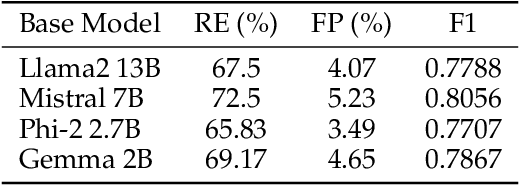

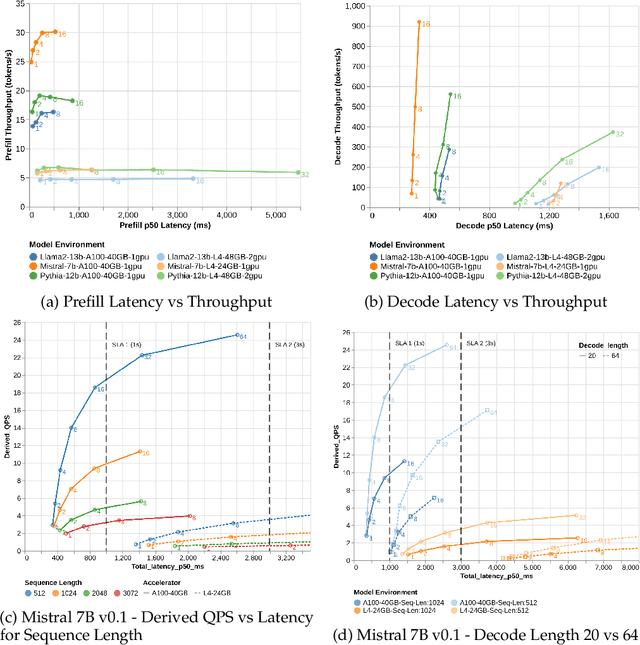
Abstract:Generative AI holds the promise of enabling a range of sought-after capabilities and revolutionizing workflows in various consumer and enterprise verticals. However, putting a model in production involves much more than just generating an output. It involves ensuring the model is reliable, safe, performant and also adheres to the policy of operation in a particular domain. Guardrails as a necessity for models has evolved around the need to enforce appropriate behavior of models, especially when they are in production. In this paper, we use education as a use case, given its stringent requirements of the appropriateness of content in the domain, to demonstrate how a guardrail model can be trained and deployed in production. Specifically, we describe our experience in building a production-grade guardrail model for a K-12 educational platform. We begin by formulating the requirements for deployment to this sensitive domain. We then describe the training and benchmarking of our domain-specific guardrail model, which outperforms competing open- and closed- instruction-tuned models of similar and larger size, on proprietary education-related benchmarks and public benchmarks related to general aspects of safety. Finally, we detail the choices we made on architecture and the optimizations for deploying this service in production; these range across the stack from the hardware infrastructure to the serving layer to language model inference optimizations. We hope this paper will be instructive to other practitioners looking to create production-grade domain-specific services based on generative AI and large language models.
MathViz-E: A Case-study in Domain-Specialized Tool-Using Agents
Jul 24, 2024



Abstract:There has been significant recent interest in harnessing LLMs to control software systems through multi-step reasoning, planning and tool-usage. While some promising results have been obtained, application to specific domains raises several general issues including the control of specialized domain tools, the lack of existing datasets for training and evaluation, and the non-triviality of automated system evaluation and improvement. In this paper, we present a case-study where we examine these issues in the context of a specific domain. Specifically, we present an automated math visualizer and solver system for mathematical pedagogy. The system orchestrates mathematical solvers and math graphing tools to produce accurate visualizations from simple natural language commands. We describe the creation of specialized data-sets, and also develop an auto-evaluator to easily evaluate the outputs of our system by comparing them to ground-truth expressions. We have open sourced the data-sets and code for the proposed system.
Agent-E: From Autonomous Web Navigation to Foundational Design Principles in Agentic Systems
Jul 17, 2024



Abstract:AI Agents are changing the way work gets done, both in consumer and enterprise domains. However, the design patterns and architectures to build highly capable agents or multi-agent systems are still developing, and the understanding of the implication of various design choices and algorithms is still evolving. In this paper, we present our work on building a novel web agent, Agent-E \footnote{Our code is available at \url{https://github.com/EmergenceAI/Agent-E}}. Agent-E introduces numerous architectural improvements over prior state-of-the-art web agents such as hierarchical architecture, flexible DOM distillation and denoising method, and the concept of \textit{change observation} to guide the agent towards more accurate performance. We first present the results of an evaluation of Agent-E on WebVoyager benchmark dataset and show that Agent-E beats other SOTA text and multi-modal web agents on this benchmark in most categories by 10-30\%. We then synthesize our learnings from the development of Agent-E into general design principles for developing agentic systems. These include the use of domain-specific primitive skills, the importance of distillation and de-noising of environmental observations, the advantages of a hierarchical architecture, and the role of agentic self-improvement to enhance agent efficiency and efficacy as the agent gathers experience.
Better RAG using Relevant Information Gain
Jul 16, 2024



Abstract:A common way to extend the memory of large language models (LLMs) is by retrieval augmented generation (RAG), which inserts text retrieved from a larger memory into an LLM's context window. However, the context window is typically limited to several thousand tokens, which limits the number of retrieved passages that can inform a model's response. For this reason, it's important to avoid occupying context window space with redundant information by ensuring a degree of diversity among retrieved passages. At the same time, the information should also be relevant to the current task. Most prior methods that encourage diversity among retrieved results, such as Maximal Marginal Relevance (MMR), do so by incorporating an objective that explicitly trades off diversity and relevance. We propose a novel simple optimization metric based on relevant information gain, a probabilistic measure of the total information relevant to a query for a set of retrieved results. By optimizing this metric, diversity organically emerges from our system. When used as a drop-in replacement for the retrieval component of a RAG system, this method yields state-of-the-art performance on question answering tasks from the Retrieval Augmented Generation Benchmark (RGB), outperforming existing metrics that directly optimize for relevance and diversity.
Automating question generation from educational text
Sep 26, 2023Abstract:The use of question-based activities (QBAs) is wide-spread in education, traditionally forming an integral part of the learning and assessment process. In this paper, we design and evaluate an automated question generation tool for formative and summative assessment in schools. We present an expert survey of one hundred and four teachers, demonstrating the need for automated generation of QBAs, as a tool that can significantly reduce the workload of teachers and facilitate personalized learning experiences. Leveraging the recent advancements in generative AI, we then present a modular framework employing transformer based language models for automatic generation of multiple-choice questions (MCQs) from textual content. The presented solution, with distinct modules for question generation, correct answer prediction, and distractor formulation, enables us to evaluate different language models and generation techniques. Finally, we perform an extensive quantitative and qualitative evaluation, demonstrating trade-offs in the use of different techniques and models.
Design and Evaluation of a Tutor Platform for Personalized Vocabulary Learning
Jul 09, 2018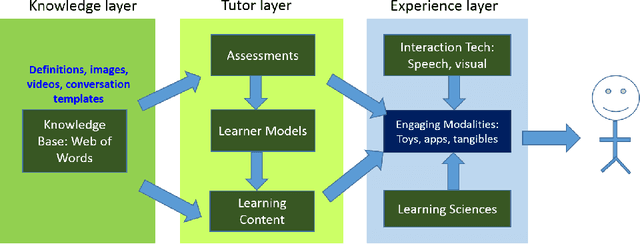

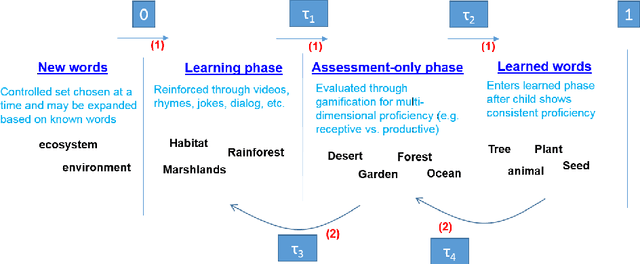
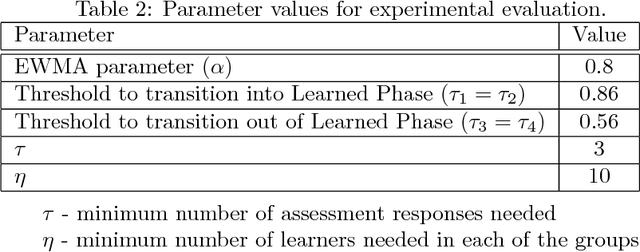
Abstract:This paper presents our experiences in designing, implementing, and piloting an intelligent vocabulary learning tutor. The design builds on several intelligent tutoring design concepts, including graph-based knowledge representation, learner modeling, and adaptive learning content and assessment exposition. Specifically, we design a novel phased learner model approach to enable systematic exposure to words during vocabulary instruction. We also built an example application over the tutor platform that uses a learning activity involving videos and an assessment activity involving word to picture/image association. More importantly, the tutor adapts to the significant variation in children's knowledge at the beginning of kindergarten, and evolves the application at the speed of each individual learner. A pilot study with 180 kindergarten learners allowed the tutor to collect various kinds of activity information suitable for insights and interventions both at an individual- and class-level. The effort also demonstrates that we can do A/B testing for a variety of hypotheses at scale with such a framework.
Human-Machine Inference Networks For Smart Decision Making: Opportunities and Challenges
Jan 29, 2018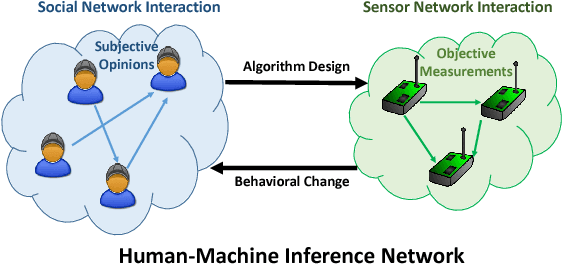
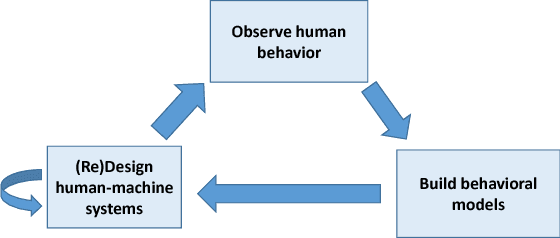
Abstract:The emerging paradigm of Human-Machine Inference Networks (HuMaINs) combines complementary cognitive strengths of humans and machines in an intelligent manner to tackle various inference tasks and achieves higher performance than either humans or machines by themselves. While inference performance optimization techniques for human-only or sensor-only networks are quite mature, HuMaINs require novel signal processing and machine learning solutions. In this paper, we present an overview of the HuMaINs architecture with a focus on three main issues that include architecture design, inference algorithms including security/privacy challenges, and application areas/use cases.
 Add to Chrome
Add to Chrome Add to Firefox
Add to Firefox Add to Edge
Add to Edge